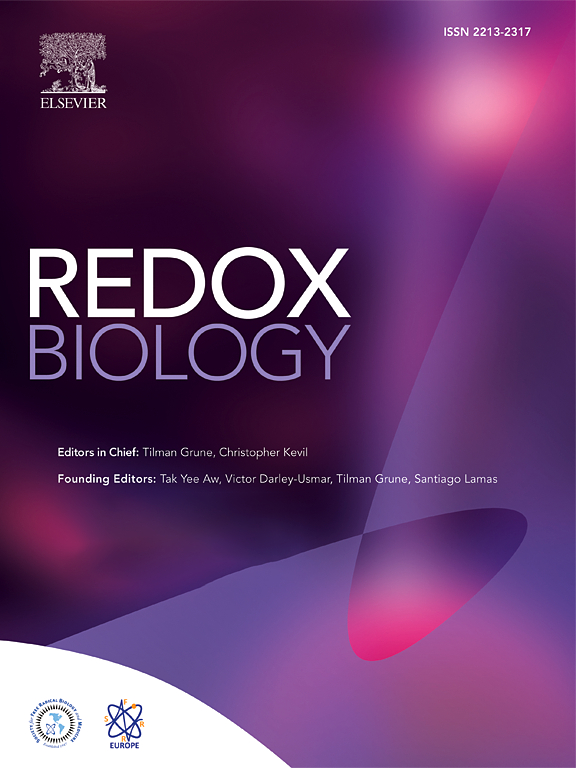肥胖引起的动脉氧化还原失衡,包括线粒体NOX4、内皮功能障碍和内质网应激,是肾损伤的基础,可通过线粒体生物能量学增强来补偿
IF 10.7
1区 生物学
Q1 BIOCHEMISTRY & MOLECULAR BIOLOGY
引用次数: 0
摘要
线粒体活性氧(mtROS)是肾病等代谢性疾病微血管并发症的关键致病因素。然而,肥胖对肾血管线粒体和内皮功能的影响尚不清楚。在高脂饮食(HFD)诱导的肥胖和内质网(ER)应激大鼠模型中,我们评估了肥胖对肾肾小球前动脉内皮功能、mtros衍生的氧化应激和线粒体生物能量学的具体影响。通过微血管肌图评估动脉功能,使用mitoSOX和Amplex Red荧光法测量mtROS水平,使用Agilent Seahorse XF Pro分析仪评估肾肾小球前动脉的线粒体呼吸。Western blot分析线粒体调节因子和内质网应激标志物的表达。我们在此证明,HFD诱导肾脏损伤和结构改变,包括肾小球肿大和纤维化,这与线粒体超氧化物增强的氧化还原失衡、内皮功能障碍和肾肾小球前动脉内质网(ER)应激有关。HFD和内质酰胺应激均导致过氧化物酶体增殖体激活受体γ共激活因子1α (PGC-1α)和NADPH氧化酶4 (NOX4)的下调,以及H2O2水平的降低,从而导致内皮功能障碍。这些变化反过来又与动脉线粒体呼吸增强以及线粒体细胞色素c氧化酶亚基4 COX-IV的上调有关,这可能与肾肾小球前动脉血流动力学改变有关,导致肾小球高滤过率(GFR)增加,以供应受损肾小球的功能。因此,目前的研究结果将线粒体生物能量学的适应性变化与肥胖引起的氧化还原平衡受损、内皮功能障碍和肾小球前动脉内质网应激联系起来。本文章由计算机程序翻译,如有差异,请以英文原文为准。
Obesity-induced arterial redox imbalance involving mitochondrial NOX4, endothelial dysfunction, and ER stress underlie kidney injury compensated by enhanced mitochondrial bioenergetics
Mitochondrial reactive oxygen species (mtROS) are key pathogenic factors in the microvascular complications of metabolic disorders including nephropathy. However, the effects of obesity on kidney vascular mitochondria and endothelial function remain unclear. We assessed here the specific impact of obesity on endothelial function, mtROS-derived oxidative stress and mitochondrial bioenergetics of kidney preglomerular arteries in rat models of high fat diet (HFD)-induced obesity and endoplasmic reticulum (ER) stress. Arterial function was assessed in microvascular myographs, mitoSOX and Amplex Red fluorimetry were used to measure mtROS levels, and mitochondrial respiration was evaluated in renal preglomerular arteries by using an Agilent Seahorse XF Pro analyzer. Expression of mitochondria regulators and endoplasmic reticulum (ER) stress markers was analyzed by Western blot. We demonstrate here that HFD induces kidney injury and structural alterations including glomerulomegalia and fibrosis associated to redox imbalance with augmented mitochondrial superoxide, endothelial dysfunction, and endoplasmic reticulum (ER) stress in renal preglomerular arteries. Both HFD and ER stress lead to impaired biogenesis and down-regulation of the peroxisome proliferator-activated receptor γ coactivator 1α (PGC-1α) and NADPH oxidase 4 (NOX4), and lower levels of H2 O2 that contribute to endothelial dysfunction. These changes are in turn associated with enhanced arterial mitochondrial respiration along with up-regulation of mitochondrial cytochrome c oxidase subunit 4 COX-IV likely related to hemodynamic changes in kidney preglomerular arteries leading to increased glomerular hyperfiltration rate (GFR) to supply function of injured glomeruli. The present findings therefore link adaptative changes in mitochondrial bioenergetics to obesity-induced impaired redox balance, endothelial dysfunction and ER stress in preglomerular arteries underlying kidney injury.
求助全文
通过发布文献求助,成功后即可免费获取论文全文。
去求助
来源期刊

Redox Biology
BIOCHEMISTRY & MOLECULAR BIOLOGY-
CiteScore
19.90
自引率
3.50%
发文量
318
审稿时长
25 days
期刊介绍:
Redox Biology is the official journal of the Society for Redox Biology and Medicine and the Society for Free Radical Research-Europe. It is also affiliated with the International Society for Free Radical Research (SFRRI). This journal serves as a platform for publishing pioneering research, innovative methods, and comprehensive review articles in the field of redox biology, encompassing both health and disease.
Redox Biology welcomes various forms of contributions, including research articles (short or full communications), methods, mini-reviews, and commentaries. Through its diverse range of published content, Redox Biology aims to foster advancements and insights in the understanding of redox biology and its implications.
 求助内容:
求助内容: 应助结果提醒方式:
应助结果提醒方式:


